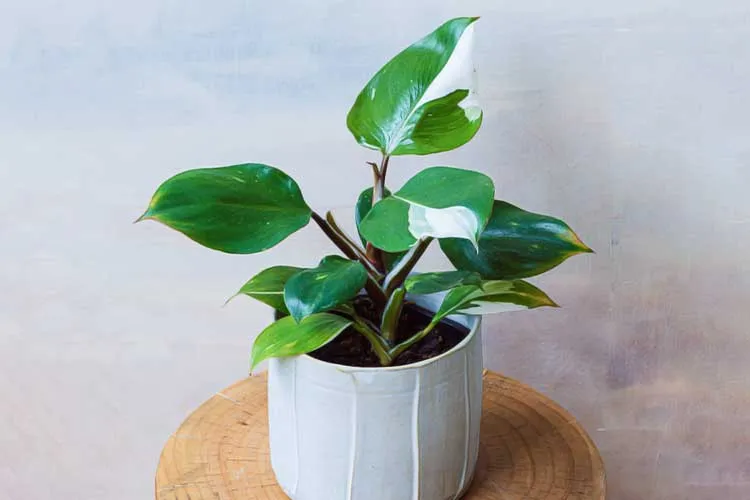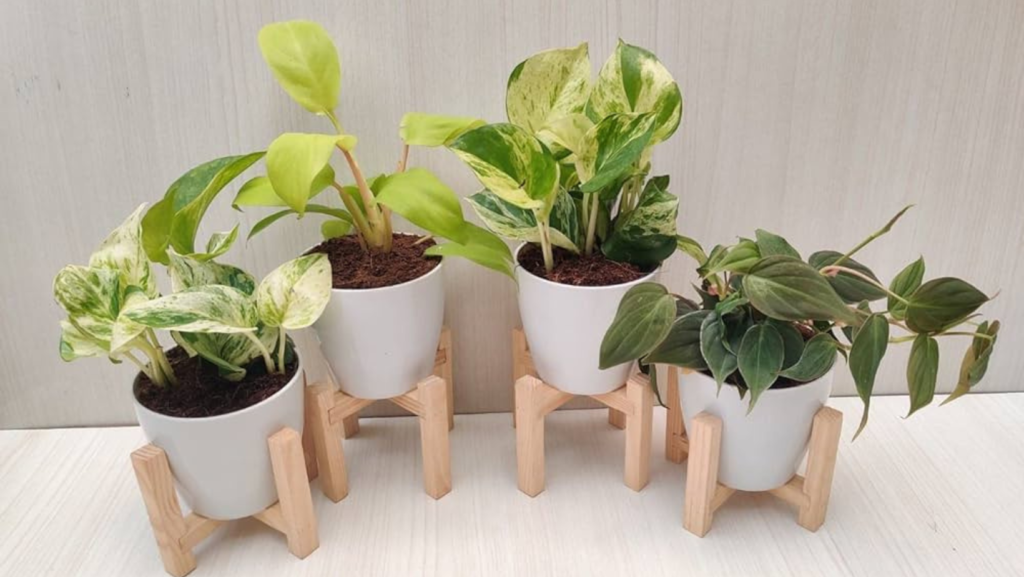Welcome to our blog post on “How to Take Care and Grow White Knight Philodendron!” If you’ve ever wanted to add a touch of elegance and greenery to your indoor space, the White Knight Philodendron is the perfect choice. In this guide, we’ll explore the essential tips and tricks to help you nurture and cultivate this stunning plant successfully. Let’s dive into the world of caring for and growing your very own White Knight Philodendron, bringing nature’s beauty right into your home!
White Knight Philodendron, scientifically known as Philodendron hastatum, is a stunning tropical plant known for its striking silver foliage and easy-care nature. Originating from Brazil, this plant is a favorite among indoor gardeners due to its unique aesthetic appeal and resilience to varying environmental conditions.
Related Blog
How to Grow and Take Care of White Knight Philodendron
The White Knight Philodendron is a houseplant with many benefits for your health and daily life. It’s easy to care and grow. Raise your White Knight Philodendron in proper conditions; it will be worth your care in the shape of timeless beauty. There are some factors to consider while taking care of a White Knight Philodendron.
Light requirements for White Knight Philodendron
Your White Knight Philodendron is like Goldilocks and her porridge—it likes its light source to be “just right.” The summary is as follows:
The secret is indirect, bright light. Consider an area of your house that is exposed to soft, diffused sunlight for the majority of the day. This can be close to a window that faces east or north. Imagine it as a spot where you can read a book without putting too much pressure on your eyes. That level of light is ideal for your philodendron.
Watch Out for the Burning Sun: The delicate variegated leaves on your plant may find direct sunlight too strong, particularly in the harsh afternoon light. The leaves may get burnt and scorched by the intense rays, creating ugly brown areas.
Controlling Southern Exposure: Don’t give up if the only windows you have face the south or west, which typically receive the most direct sunlight! It is still possible to construct an appropriate setting. The trick is to use a sheer curtain to filter the light. This softens the intense light, giving your philodendron the soft light it needs.
Water need
Finding the right balance between providing your White Knight Philodendron with enough water and preventing root rot is crucial. Here’s how to locate the ideal point:
Allow Soil to Dry Out Between Waterings: Use the top inch of soil as a proxy for moisture. Put your finger in and see if it feels dry; if so, watering time is needed. Wait a few more days if it feels moist.
Philodendrons can withstand more submersion in water than they can with overwatering, thus underwatering is preferable. Why? For overwatering can induce root rot, a fatal disease in which the roots suffocate from being submerged in water all the time.
Give your philodendron a healthy drink after you soak it thoroughly, but avoid drowning it. Water escapes the drainage holes at the bottom of the pot and saturates the soil. This guarantees that hydration reaches every root.
Humidity
White Knight Like many other tropical plants, philodendrons prefer humidity levels between 60% and 70%. Our houses are often dryer, particularly in the winter. Here’s how to give your plant a more humid environment:
The Pebble Tray Trick is as simple as setting your philodendron on a tray that has water and stones on it. The surrounding humidity rises when the water vapor evaporates. To prevent the pot from sitting in water, always remember to maintain the water level below the stones.
Power of Humidifier: To directly add moisture to the air, get a humidifier. This helps any other plants you may have that like dampness as well as your philodendron.
Strategy for Plant Grouping: You can create a microclimate with increased humidity levels by grouping your White Knight Philodendron with other plants that thrive in damp conditions. Naturally, the plants cooperate to keep the surrounding air more humid.

Soil
The kind of soil you choose is very important for the health of your philodendron. What you should know is as follows:
Drainage is king, so use a potting mix that drains well. This keeps the roots from rotting by allowing extra water to escape easily.
Aeration Is Also Vital: Good aeration and drainage frequently go hand in hand. The roots may breathe thanks to air gaps in the soil, which encourages strong growth.
The Ideal Combination: A mixture of peat moss, perlite, and orchid bark is a fantastic choice for your White Knight Philodendron. While perlite and orchid bark offer drainage and aeration, peat moss holds onto moisture.
Fertilizer: An Adaptable Sustain
During its active growing season, fertilizer can help your White Knight Philodendron grow even more vigorously. Here’s how to make good use of it:
Feeding in the Spring and Summer: Every four to six weeks, when your philodendron is actively growing in the spring and summer, fertilize it with a balanced, diluted liquid fertilizer.
Don’t Overdo It: When it comes to fertilizer, less really is more. The suggested dosage on the fertilizer package should always be followed. Overfertilizing a plant can hurt it and damage its roots.
Acceptable Guidelines for Fertilization Philodendron White Knight
- Fertilizer Type:
- Use a well-balanced fertilizer with a balanced NPK ratio, such as 10-10-10, to provide essential nutrients like nitrogen, phosphorus, and potassium for healthy growth.
- Fertilizing Schedule:
- During the growing season in spring and summer, fertilize your White Knight Philodendron every 1-2 weeks to support its growth phase. Reduce fertilization to once a month in the fall and avoid fertilizing in winter when the plant is dormant.
- Application Method:
- Dilute the fertilizer to half the strength recommended on the package to ensure even nutrient distribution. Water the plant evenly with the diluted fertilizer solution to provide the necessary nutrients without overwhelming the plant.
- Avoid Over-Fertilization:
- Be cautious not to over-fertilize your Philodendron White Knight, as it can lead to nutrient burn, resulting in damage to the roots and foliage. Signs of over-fertilization include salt buildup on the soil surface or leaf tip burn.
Temperature: Determining the Ideal Range
White Knight Although philodendrons don’t mind the odd temperature, there is a sweet spot for growth:
The ideal room temperature is between 18-27C or 65 and 80 degrees Fahrenheit. Since most households feel comfortable in this temperature range, your philodendron is probably going to be content where it is.
How to Repotting White Knight Philodendron
Your White Knight Philodendron will eventually outgrow the pot it is in as it grows. This is when and how to pot again:
Look for indications that your philodendron requires a larger pot if it appears to be rootbound. These include drooping leaves even with adequate hydration, poor development, or roots that wrap around the bottom of the pot.
The timing is crucial. Repotting is best done in the spring or summer when growth is most active. This makes it easier for the plant to bounce back from the stress of repotting.
Selecting the Appropriate Pot: Choose a pot that is only 1-2 inches wider and slightly bigger than the one you have. An too large pot may retain too much moisture, which raises the possibility of root rot.
New Potting Mix: When repotting, use fresh, well-draining potting mix. Old soil should not be repurposed as it may contain illnesses and pests.
How to prune White Knight Philodendron
Maintaining the shape of your White Knight Philodendron and promoting new growth are the two goals of pruning. This is how to prune trees well:
Snip Off the Unwanted: Remove yellowing, damaged, or lanky leaves on a regular basis. This maintains the plant’s tidy appearance.
To promote bushier growth, you can also pinch back stems. This entails trimming off a tiny piece of a growing stem’s tip. This will encourage new branching to emerge from beneath the incision, making the plant bushier and fuller overall.
Methods of Propagation
Stem cuttings are an easy way to propagate White Knight Philodendron. To ensure successful propagation, adhere to these steps:
- Pick a robust stem that has several leaves.
- Make a clean incision immediately below a node using a sharp, sterilised knife.
- Make sure the cutting is submerged in the water by placing it in a jar.
- Change the water in the jar every few days and store it somewhere warm and bright.
- Plant the cutting in a shallow pot with a moist potting mix once roots have begun to appear.
Support
A Philodendron White Knight grows more quickly when planted close to structural support, like a tree or pole. This is due to the inherent mechanisms that climbing plants, such as the Philodendron White Knight, have for spreading and climbing. When they come to a support structure, they can use it to help them climb higher, reaching for the sunlight to spread out their leaves.
When growing in the absence of any adjacent support structures, White Knight plants typically reach a height of about three metres. It can, however, outgrow this typical growth rate if planted next to a pole or tree. This is because, instead of concentrating only on vertical growth, the plant uses its energy to ascend and spread when it detects a nearby support. The plant is able to grow faster and taller than it would have otherwise without this support.
Essentially, the Philodendron White Knight can climb and develop more effectively when there is a support structure present, which enables it to reach higher altitudes than it might otherwise.
Typical Problems with White Knight Philodendron and Solutions
Turning Yellow Leaves
Yellowing foliage may be a sign of underwatering or overwatering. To avoid soggy soil, alter the frequency of your irrigations and make sure that the soil is properly drained.
Infestations of Pests
Look out for typical pests like aphids and spider mites. If needed, apply insecticidal soap to the plant after wiping the leaves with a moist cloth to get rid of any bugs.
Leaf Browning
Low humidity or direct sunshine exposure can both result in leaf browning. Relocate the plant to a more comfortable spot and use a humidifier or spray to raise the humidity level.
White Knight Philodendron Benefits
Having a White Knight Philodendron in your home offers various benefits as some are:
- Air Purification:
- Philodendron White Knight, like other houseplants, helps purify the air by removing harmful toxins and pollutants such as formaldehyde, benzene, and volatile organic compounds (VOCs).
- Aesthetics:
- The plant’s large, heart-shaped leaves with striking white or silver colouring make it an attractive addition to indoor spaces, adding elegance and sophistication to your decor.
- Mood Boosting:
- Studies have shown that having plants indoors, like the Philodendron White Knight, can improve mood and reduce stress levels, creating a calming and relaxing atmosphere in any room.
- Indoor Gardening:
- For those interested in indoor gardening but lacking outdoor space, the Philodendron White Knight is a great option. It is relatively easy to care for and can thrive in various indoor environments.
Pet Toxicity of Philodendron White Knight
The following sources emphasise how important it is for pet owners to take into account the toxicity of White Knight Philodendron to animals:
Pet toxicity: Crystals of calcium oxalate found in Philodendron White Knight are poisonous to animals and people alike. Pets may exhibit symptoms like vomiting, lack of appetite, drooling, and pawing at the mouth if they consume any component of the plant. These signs point to a possible poisoning, thus it’s important to keep the plant out of the reach of kids and animals to avoid ingestion.
The severity of Symptoms: Pets that consume White Knight Philodendron may have discomforting symptoms such as drooling, decreased appetite, and mouth soreness. It’s critical to recognise these symptoms and respond quickly by getting in touch with a veterinarian if poisoning is suspected. Keeping the plant away from pets and providing a safe environment is crucial to prevent accidental ingestion and poisoning incidents.
In the end
With the right care and attention, your White Knight Philodendron can thrive and beautify your indoor space for years to come. By providing adequate light, water, and humidity, you can enjoy the lush foliage and elegant charm of this tropical beauty. Happy gardening!


